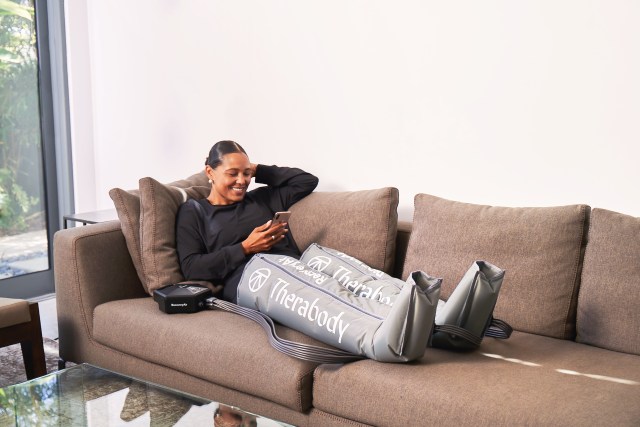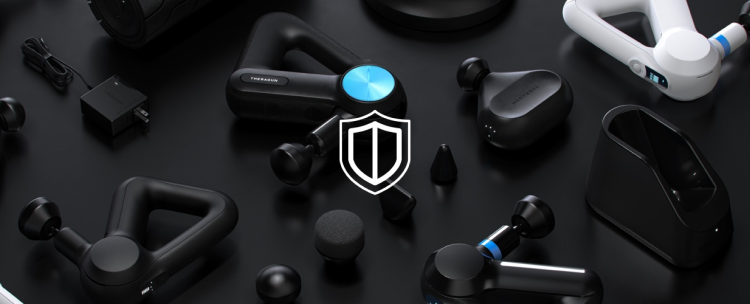Authors: Therabody Scientists: Tim Roberts, MSc; Kyle Silvey, PhD, CSCS; Michelle Darian, MS, MPH, RD, LDN
Pneumatic compression devices have evolved into a coveted recovery tool, and for good reason. The first one is, they work. Research has consistently shown since the 1950s that pneumatic compression helps reduce swelling, decrease soreness and muscle stiffness, and improve range of motion. [1,2,3] The second reason is that a high-quality pneumatic compression device (one that delivers these science-backed benefits) can be an investment — so you may wonder whether or not it’s worth it.
And it’s no secret that Therabody’s™ JetBoots® line is considered one of the best (and even the most luxurious) choices out there for this tech when it comes to efficacy and safety. That’s because Therabody doesn’t cut corners when it comes to product best practices and ease-of-use features while delivering effective treatments. There are many design and technology elements that Therabody’s team of engineers and scientists knew they wanted to incorporate into pneumatic compression devices’ design and development to ensure that treatments safely and effectively deliver recovery. We’re peeling back the curtain on eight of them that made their way into JetBoots technology that can help maximize recovery and make the boots easy to implement into your everyday recovery routine.
But First, How Does Pneumatic Compression Work?
Pneumatic compression systems involve an air pump and garments (like boots) that inflate and deflate while worn on your body. The pump then delivers compressed air (usually intermittently and sequentially) to mimic the body’s natural muscle pump action — or the physiological action that promotes blood flow and circulation back to the heart. [4]
For context, the lymphatic system relies on muscle contraction to move the lymph (or fluid-containing immune cells). This helps to filter out waste products in the blood that can lead to soreness post-exercise. [5]
This pressure enhances the body’s natural healing processes, delivering more oxygen and nutrients to the muscles and transporting waste products from exercise away from the muscles. The improvements in circulation also help reduce swelling and fluid buildup, so you feel less stiff and sore, making this an effective method for recovery, particularly after physical activity. [6] The way in which science meets technology can differ between devices, for example:
- How much pressure is delivered
- How that pressure is delivered (and released)
- How the pressure is controlled
- Where the pump is located
When deciding on a technology to choose, you’ll notice that some devices are scientifically superior and easier to use than others. We recommend devices that are designed by science because they deliver efficient and effective treatments. And at the end of the day, easy-to-use technology is more likely to make its way into your daily wellness and recovery routines.
8 Things to Look For in a Pneumatic Compression Device
1. Efficient Flush Cycles
A flush cycle refers to how long it takes for the boot to completely inflate and deflate. Once a cycle is complete, another one starts, and this continues throughout your treatment session. You want the cycle time to be efficient so that you get more cycles in less time per session for a faster and maximized recovery. Research shows that a faster cycle time can lead to greater benefits. This is likely due to increased circulation during a treatment of a set duration. [7,8]
Each pneumatic compression device should state the cycle length. For example, Therabody’s JetBoots use FastFlush™ Technology to deliver compression cycles 2-3x faster than the leading competitor. Each cycle (from full inflation to deflation) takes just 60 seconds.
So, in a 30-minute recovery session, JetBoots provide 30 cycles, whereas a boot that takes 120 seconds to inflate and deflate would only deliver 15 cycles within that same treatment session.
2. A Sequential Pressure System
To optimize circulation and remove metabolic waste safely and effectively, you want to look for a device that has a sequential pressure system. This means that gradual pressure starts from the feet and travels up the thighs. The sequential pattern is possible because of the pressure chambers within the boots. Different boots will have a different number of chambers. [1]
Therabody’s JetBoots use TruGrade™ Technology to deliver consistent, sequential pressure up the leg (a true negative gradient). And each of the boots’ four chambers overlap, so there aren’t any gaps in the pressure’s delivery (which can be harmful). This ensures that the blood and lymph do not pool or move back toward the heart and lymph nodes.
3. Precise Pressure, Regardless of Leg Size
When you purchase pneumatic compression garments, you select a size (e.g., small, medium, large) based on your height. That said, the garment should still be suitable for a variety of leg sizes and widths. For example, if a runner and a linebacker are about the same height, they should still be able to wear the same size garment.
Some systems only deliver a set amount of pressure regardless of the leg size, which can lead to dangerous over-constriction and numbness. But Therabody’s JetBoots delivers massage pressure based on the size of your leg, ensuring that various leg sizes will experience the same amount of pressure when selecting the same treatment settings. The precise pressure control not only optimizes recovery but also provides a safer massage experience.
4. Full Release of Compression
The compression part of pneumatic compression pushes metabolic waste out of muscles. And the complete release of that pressure allows fresh, oxygenated blood to flow back into the muscles more efficiently — supporting recovery processes. [9] After each flush cycle, the pressure is completely released from the legs to more effectively speed up recovery.

5. Wireless Convenience
Pneumatic compression garments require a pump, which may leave you tethered to an outlet. More than anything, this limits where you can use the device. Some devices offer a completely wireless design with the pump built into the garment — so you can slip them on wherever.
For JetBoots, the pumps are built into the bottom of each boot, so there are no tubes to connect or wires to plug in during a session. The only time you plug the boots in is to charge (which you can also do during your treatment if you prefer). There’s also no remote to keep track of because the control panel is built into the boots. You can also control and manage pressure and time settings for your JetBoots boot treatments through the Therabody App.
6. Hygienic and Easy-To-Clean Material
The material of pneumatic compression boots can vary greatly, and some material requires more care and maintenance than others. Look for an option that uses medical-grade, non-porous material. Ideally, the interior should also be lined to create one smooth surface. If it’s not lined, there will likely be chamber flaps that are hard to clean, which becomes a magnet for bacteria and unpleasant odors.
7. Has Science-Backed Preset Treatments
Pneumatic compression is a science-backed therapy. Some pressures and session lengths are better suited for certain outcomes (whether that’s a warm-up or recovery). But it shouldn’t be up to you to research those optimal settings. Pneumatic compression devices should come with preset routines curated by professionals that take the guesswork out of how to best set the massage cycle, pressure, and session length.
For example, within the device itself and through the Therabody App, you can select routine preset treatments scientifically designed to maximize warm-ups and recovery.
8. Ability to Customize Treatments
Having the option to customize treatments is just as important as having preset options. You’ll want to be able to adjust the pressure, session length, hold and release time, and more. Because at the end of the day, you know what feels right for your body. The ability to customize treatments also extends to your personal healthcare professional — who can recommend specific settings based on your needs and history.
With JetBoots, you can control and customize your treatments all through the Therabody App or by using the built-in control panel on the boot. And your boots remember your treatment preferences — the settings you select on your last treatment session become the default settings on your next one.
Key Takeaways
- Pneumatic compression boots are a (rightfully) popular recovery tool, but deciding on a device to invest in can feel overwhelming.
- Therabody’s JetBoots line follows best practices when it comes to the science and technology of the therapy (think efficient cycles, a full release, and sequential pressure).
- Ease-of-use product features are also important for actual adoption, so JetBoots provides wireless, easy-to-care-for, and easy-to-use features for both novice and experienced pneumatic compression users.
References:
- https://journals.sagepub.com/doi/10.1177/1076029616683044
- https://www.ncbi.nlm.nih.gov/pmc/articles/PMC150384/
- https://pubmed.ncbi.nlm.nih.gov/27533094/
- https://www.jvascsurg.org/article/S0741-5214(02)75244-0/fulltext
- https://pubmed.ncbi.nlm.nih.gov/29104671/
- https://pubmed.ncbi.nlm.nih.gov/19499765/
- https://pubmed.ncbi.nlm.nih.gov/15990691/
- https://www.ncbi.nlm.nih.gov/pmc/articles/PMC3629206/
- https://pubmed.ncbi.nlm.nih.gov/10757194/







